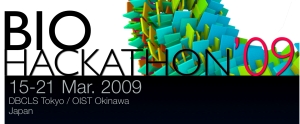| 387 | | Before the BioHackathon started, we first began by discussing among Japanese database providers including The University of Tokyo as the KEGG provider, Osaka University as the PDBj provider, Computational Biology Research Center, Biomedicinal Information Research Center and Database Center for Life Science to make the web services on the databases work together. Then, the first guildeline for designing web services was proposed in Japanese in October, 2008. We improved it to be applicable to variable databases and easy to understand even for a beginner of web services. After that, we translated it to English to sharpen at the BioHackathon 2009. |
| | 387 | Prior to BioHackathon 2009, we first began by discussing among Japanese database providers including The University of Tokyo as the KEGG provider, Osaka University as the PDBj provider, Computational Biology Research Center, Biomedicinal Information Research Center and Database Center for Life Science to make the web services on the databases work together. Then, the first guildeline for designing web services was proposed in Japanese in October, 2008. We improved it to be applicable to variable databases and easy to understand even for a beginner of web services. |
| | 388 | |
| | 389 | At BioHackathon 2009, first we joined the discussion at the other working groups to try to incorporate the aspects from the other research communities. We joined the discussion at “GlycoBiology”, “Literatures”, “BigData” and “SeantecWebServise” working groups. At “GlycoBiology” working group, we introduced the use case of data integration using web services of two biological databases, an integrated human gene database (H-InvDB; http://h-invitational.jp/) and GlycoGene DataBase (GGDB; http://riodb.ibase.aist.go.jp/rcmg/ggdb/). Then we actually tried to build a workflow to relate and assign the disease-related information using the additional Bio-WSs, there we had a confidence that Bio-WS guideline will benefit to the biological database users. |
| | 390 | |
| | 391 | To propose the Bio-WS guidelines BioHackathon 2009 participants and widely to the public, we translated the first version of the guidelines to English to sharpen at BioHackathon 2009. In brief, this manifest of the Bio-Web Service guideline proposed the standard specifications of methods of REST and SOAP to search, get or convert ID or format of the entries. It also proposed the format of query string and supported data types, as well as the preparation of sample codes and documents. The full descriptions of the manifest were stated at the following |
| | 392 | URL; http://hackathon2.dbcls.jp/wiki/GuidelineForWebService. |
| | 393 | |
| | 394 | As a conclusion, we had proposed the Bio-WS guideline to BioHackathon 2009 participants. Further discussion and brushing up of the detailed spesifications will be required for the guideline to be an authorized international standard guideline for the Bio-Web Service developments, but we will continue this activity. The future version of the guideline may incorporate the aspects of the Semantic Web Services. |
| | 395 | |
